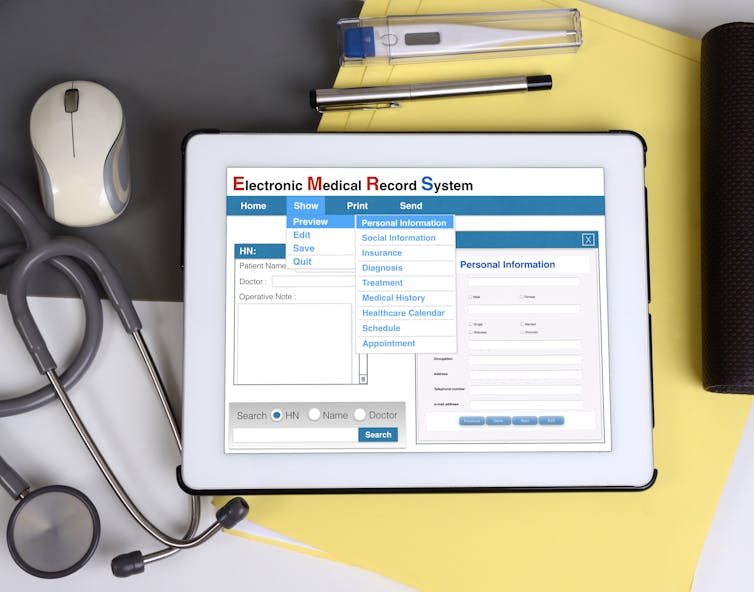Physician burnout: Why legal and regulatory systems may need to step in
- Written by Sharona Hoffman, Professor of Health Law and Bioethics, Case Western Reserve University
A career as a physician[1] has traditionally been considered to be among the best vocations that talented students can pursue. That may no longer be the case. All too many doctors report that they are unhappy, frustrated and even prepared to leave the profession. That should worry all of us. The physician burnout crisis is likely to affect our quality of care and our access to health care providers.
According to a recent study[2], 44% of U.S. doctors suffered at least one symptom of burnout, and some studies have identified even higher burnout rates[3]. By contrast, researchers have found only a 28%[4] burnout rate in the general working population.
In a forthcoming academic article[5], I argue that physician burnout is as much a legal problem as it is a medical one. Many laws and regulations protect the health and welfare of American workers. This is particularly true when public safety depends on those jobs. Regulations limit the work hours of air traffic controllers[6], pilots[7], flight attendants[8] and other transportation workers so they are well rested on the job.
Likewise, physicians have safety-critical jobs because patients routinely put their lives in doctors’ hands. That’s why I believe policymakers must turn their attention to the needs of doctors.
Understanding physician burnout
 Electronic health record systems are adding extra pressure to physicians, causing burnout.
pandpstock001/shutterstock.com[9]
Electronic health record systems are adding extra pressure to physicians, causing burnout.
pandpstock001/shutterstock.com[9]
Burnout, characterized[10] by emotional exhaustion, loss of identity and dissatisfaction with work accomplishments, is commonly measured by a tool called the Maslach Burnout Inventory[11].
Physician burnout can be ruinous for both doctors and their patients. Burnout can lead[12] to depression, insomnia, addiction and even thoughts of suicide. Profoundly unhappy and unwell physicians, in turn, may have difficulty[13] concentrating at work and providing high-quality medical care. In addition, they may opt to leave clinical practice or to reduce work hours[14] in order to alleviate stress. Because our population is aging, and the U.S. is already experiencing physician shortages[15], a shrinking physician workforce would be of grave concern.
What is causing physician burnout? Electronic health record systems are partly to blame. In the paper era, doctors could jot down notes at their discretion or dictate notes that assistants would type. But now they must work directly with computers and meet extensive record-keeping demands. Documentation takes as much as 50%[16] of physicians’ time, including “pajama time[17]” – hours spent during evenings and weekends.
For example, according to one study, emergency room physicians went through 4,000 mouse clicks[18] in a 10-hour shift. Some doctors feel that they have evolved into “unhappy data-entry clerks[19].” Some also feel that they provide more treatment[20] to the computer than to the patient in the examination room.
In addition, physicians face many regulatory and administrative burdens. Electronic health record systems are accompanied by “meaningful use[21]” regulations with which physicians must comply. These regulations require clinicians to show that they are using certified electronic health record technology in particular, measurable ways.
Doctors also spend time on many insurance-related matters[22] for which they do not receive compensation. These include eligibility verification, billing, prior authorization, appeals of coverage denials and more. Furthermore, physicians must report a multitude of quality and performance measures[23] to regulators and insurers.
In addition, physicians are under pressure to generate revenues. Today, fewer than 50%[24] of physicians work independently. More typically, doctors are employed by health care organizations such as hospitals or hospital-owned practices. Employers often induce physicians to see more patients and meet financial targets, even tying their salaries to productivity[25].
All of these obligations result in physicians being unable to spend adequate time face to face with patients. The average primary care visit is only 15 to 20 minutes. That often is not enough time for a doctor to listen to, examine, diagnose and provide thorough explanations to patients.
As the population ages and more people develop multiple and complex health problems, physicians need more time[26] to assess patients and coordinate their care. Doctors who feel that they are short-changing patients are likely to be frustrated and unhappy. The rushed patient visit is thus another significant contributor to physician burnout.
Addressing physician burnout
 Employers who can find the cause of burnout could help lower the rates.
Thunderstock/shutterstock.com[27]
Employers who can find the cause of burnout could help lower the rates.
Thunderstock/shutterstock.com[27]
What can be done to combat physician burnout? Several legal steps can be taken.
First, regulators should streamline the regulations that apply to physicians. For example, required quality measures can be pared down to focus on those related to treatment outcomes. Physicians should not be asked to collect data if it cannot clearly be put to practical use.
Second, regulators should revisit the process for certifying electronic health record systems. The certification process[28] should include extensive usability testing, which is currently lacking. Electronic health record systems must be as user-friendly and easy to operate as possible. They must help physicians work more efficiently and avoid mistakes rather than being a burden that contributes to burnout.
Third, regulations should require health care employers to assess physician wellness periodically. This can be done using the Maslach Burnout Inventory[29] or a similar tool.
Employers who learn of high burnout rates in their work forces will presumably be motivated to address the problem. They might offer physicians more flexible schedules to enhance work-life balance. They might also hire additional staff to assist physicians with administrative tasks. Professionals known as “scribes[30]” can be particularly helpful. Scribes shadow physicians and do much of the data entry[31] work for them. Medicare could create incentives for health care employers to implement interventions by awarding bonus points[32] for reduced burnout rates. Bonus points can translate into higher payment amounts for health care providers.
A physician burnout rate of 44% or higher is a public health crisis. It is dangerous for both physicians and their patients. Burnout is a problem that demands urgent attention and that policymakers cannot afford to ignore.
[ Like what you’ve read? Want more? Sign up for The Conversation’s daily newsletter[33]. ]
References
- ^ career as a physician (www.mdmag.com)
- ^ study (www.mayoclinicproceedings.org)
- ^ higher burnout rates (physiciansfoundation.org)
- ^ 28% (www.mayoclinicproceedings.org)
- ^ academic article (papers.ssrn.com)
- ^ air traffic controllers (www.law.cornell.edu)
- ^ pilots (www.thebalancecareers.com)
- ^ flight attendants (www.forbes.com)
- ^ pandpstock001/shutterstock.com (www.shutterstock.com)
- ^ characterized (www.ncbi.nlm.nih.gov)
- ^ Maslach Burnout Inventory (nam.edu)
- ^ lead (www.cghjournal.org)
- ^ difficulty (labblog.uofmhealth.org)
- ^ leave clinical practice or to reduce work hours (www.annfammed.org)
- ^ shortages (news.aamc.org)
- ^ 50% (nam.edu)
- ^ pajama time (nam.edu)
- ^ 4,000 mouse clicks (epmonthly.com)
- ^ unhappy data-entry clerks (www.ncbi.nlm.nih.gov)
- ^ more treatment (www.forbes.com)
- ^ meaningful use (www.cdc.gov)
- ^ insurance-related matters (annals.org)
- ^ quality and performance measures (jamanetwork.com)
- ^ fewer than 50% (www.medicaleconomics.com)
- ^ productivity (www.postandcourier.com)
- ^ more time (www.ncbi.nlm.nih.gov)
- ^ Thunderstock/shutterstock.com (www.shutterstock.com)
- ^ certification process (www.healthit.gov)
- ^ Maslach Burnout Inventory (nam.edu)
- ^ scribes (www.nytimes.com)
- ^ data entry (www.ama-assn.org)
- ^ bonus points (aahpm.org)
- ^ Sign up for The Conversation’s daily newsletter (theconversation.com)
Authors: Sharona Hoffman, Professor of Health Law and Bioethics, Case Western Reserve University

